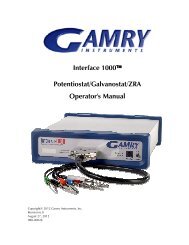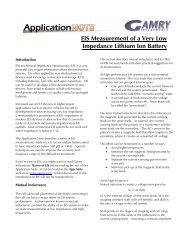Basics of Electrochemical Impedance Spectroscopy - Gamry ...
Basics of Electrochemical Impedance Spectroscopy - Gamry ...
Basics of Electrochemical Impedance Spectroscopy - Gamry ...
You also want an ePaper? Increase the reach of your titles
YUMPU automatically turns print PDFs into web optimized ePapers that Google loves.
For linear impedance elements in series you calculate<br />
the equivalent impedance from:<br />
Z eq = Z 1 + Z 2 + Z3<br />
(9)<br />
Z<br />
1<br />
Z 2<br />
Z 3<br />
Figure 10. <strong>Impedance</strong>s in Parallel<br />
For linear impedance elements in parallel you calculate<br />
the equivalent impedance from:<br />
We will calculate two examples to illustrate a point<br />
about combining circuit elements. Suppose we have a<br />
1 Ω and a 4 Ω resistor in series. The impedance <strong>of</strong> a<br />
resistor is the same as its resistance (see Table 1). We<br />
thus calculate the total impedance as:<br />
(10)<br />
Z eq = Z 1 + Z 2 = R 1 + R 2 = 1 Ω + 4 Ω = 5 Ω<br />
Resistance and impedance both go up when resistors<br />
are combined in series.<br />
Now suppose that we connect two 2 µF capacitors in<br />
series. The total capacitance <strong>of</strong> the combined<br />
capacitors is 1 µF.<br />
Z = Z + Z = 1/ jωC + 1/ jωC eq 1 2 1 2<br />
= 1/ j ω( 2e − 6) + 1/ jω( 2e<br />
− 6)<br />
= 1/ jω(<br />
1e − 6)<br />
<strong>Impedance</strong> goes up, but capacitance goes down when<br />
capacitors are connected in series. This is a<br />
consequence <strong>of</strong> the inverse relationship between<br />
capacitance and impedance.<br />
6<br />
Physical Electrochemistry and Equivalent<br />
Circuit Elements<br />
Electrolyte Resistance<br />
Solution resistance is <strong>of</strong>ten a significant factor in the<br />
impedance <strong>of</strong> an electrochemical cell. A modern 3<br />
electrode potentiostat compensates for the solution<br />
resistance between the counter and reference<br />
electrodes. However, any solution resistance between<br />
the reference electrode and the working electrode must<br />
be considered when you model your cell.<br />
The resistance <strong>of</strong> an ionic solution depends on the ionic<br />
concentration, type <strong>of</strong> ions, temperature, and the<br />
geometry <strong>of</strong> the area in which current is carried. In a<br />
bounded area with area, A, and length, l, carrying a<br />
uniform current, the resistance is defined as,<br />
R<br />
l<br />
= ρ (11)<br />
A<br />
ρ is the solution resistivity. The reciprocal <strong>of</strong> ρ (κ) is<br />
more commonly used. κ is called the conductivity <strong>of</strong><br />
the solution and its relationship with solution resistance<br />
is:<br />
1 l l<br />
R = ⇒ κ =<br />
κ A RA<br />
. (12)<br />
Standard chemical handbooks will <strong>of</strong>ten list κ values for<br />
specific solutions. For other solutions, you can calculate<br />
κ from specific ion conductances. The unit <strong>of</strong> κ is the<br />
Siemens per meter (S/m). The Siemen is the reciprocal<br />
<strong>of</strong> the ohm, so 1S=1/ohm.<br />
Unfortunately, most electrochemical cells do not have<br />
uniform current distribution through a definite<br />
electrolyte area. The major problem in calculating<br />
solution resistance therefore concerns determination <strong>of</strong><br />
the current flow path and the geometry <strong>of</strong> the<br />
electrolyte that carries the current. A comprehensive<br />
discussion <strong>of</strong> the approaches used to calculate practical<br />
resistances from ionic conductances is well beyond the<br />
scope <strong>of</strong> this manual.<br />
Fortunately, you usually don't calculate solution<br />
resistance from ionic conductances. Instead, you<br />
calculate it when you fit experimental EIS data to a<br />
model.




